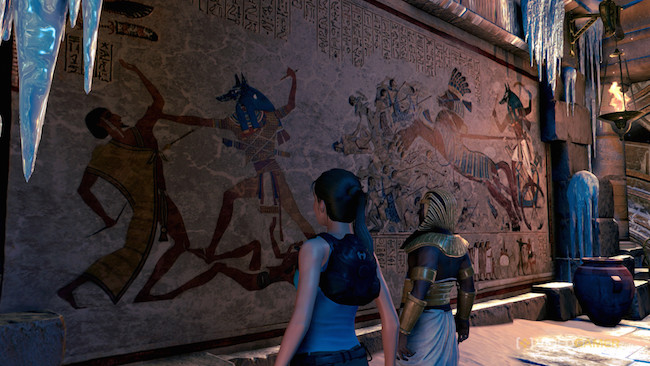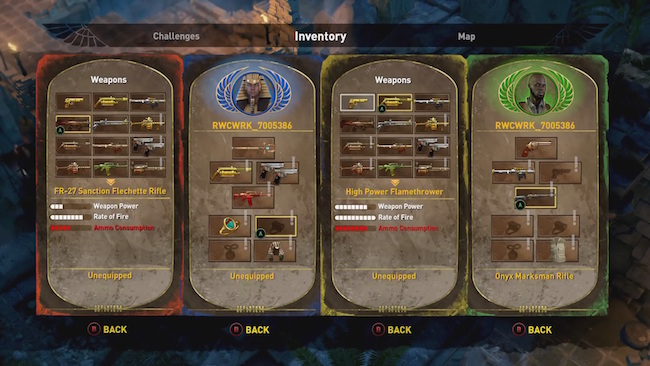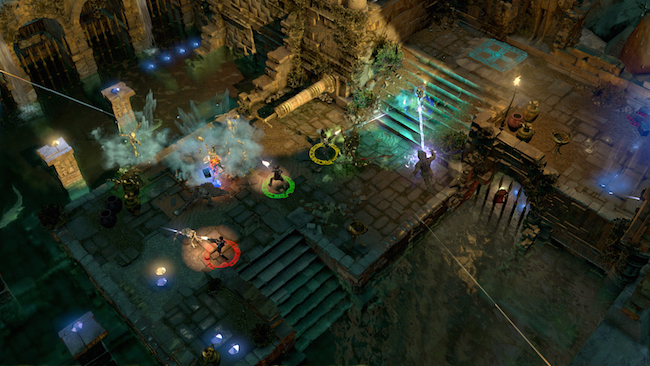
Lara Croft and the Temple of Osiris is the successor to Lara Croft and the Guardians of Light; the wildly successful beginning of the tangential Lara Croft franchise. Available now for digital download on Xbox One, PS4 and Steam, it has some big shoes to fill in order to live up to its predecessor.
The game takes place in a semi-fictional Egyptian setting, beginning with the titular Lara and her American counterpart / rival Carter Bell racing to secure the staff of Osiris. Arriving at the same time, the pair inadvertently loosen the seal on the prison of the evil god, Set and brand themselves for death.
The events also awaken Horus and his mother Isis, the wife of Osiris, who befriends and fight alongside the tomb raiders. The gods also reveal that in order to counter the weakening of Sets prison and the curse inflicted upon them, Lara and Carter must find the scattered pieces of Osiris in order to revive him so that he may confront Set directly.
Incidentally, Lara must have seen some shit in her time because she reacts to the awakening of ancient gods and proof of life beyond the grave in much the same way as a normal person would react to news of bad traffic; a slight inconvenience that she’s just going to have to deal with. Although, loosening the ties between reality and the story does add a fun twist to the narrative. Furthermore, it also sets up a nice little framework for the game to progress in: reclaim the scattered pieces of a dead god, but don’t worry, it’s all in good fun.

Continuing in the same vein as its predecessor; Temple of Osiris is a top-down dungeon crawler with a strong emphasis on co-op play and puzzle-solving. The bulk of the game is based around the hub of Osiris’s shrine with levels branching out around it.
Level progression is organically linked to the story through a machine created by the dead god, Osiris, which controls the weather. Unlocking various settings on the machine will allow flood waters to recede, alter the time of day and change the season, allowing access to previously inaccessible areas.
The time of day and weather also affect what loot is available through the hub area chests, which adds a more thoughtful element to how you spend your earned gemstones. To clarify, gemstones are earned through combat and exploration and need to be spent in order to open the chests found at the end of levels and in the hub area.
The cheaper, more common chests will give out mediocre gear, usually buffing one stat and the expense of another. While saving up for the more expensive chests will yield rings and amulets with several buffs and minimal weaknesses. This gives players the choice of spamming the cheap chests in the hope of getting a piece of gear that suits their play-style, or saving up for a more expensive loot chest and then fitting their style of play around the loot it drops.

Weapons, however, are based purely on level progression; sometimes they’re behind a fence or other obstacle, but never out of your way. Although it may take away some of the feeling of having ‘earned’ your new method of causing death and destruction, there’s a lot to be said for essentially getting a free bazooka.
Gameplay-wise, the weapons don’t vary that much; rifles for mid and long range enemies, shotguns for close-up work and grenade launchers or bazookas for bosses. Although there are variations on each class, I found that moving outside of the old assault-rifle/shotgun combo made things difficult.
Weapons all pull ammunition from one generic ammo pool, with heavier weapons using more per shot than their lighter counterparts. Ammo drops are pretty common, however, and I never found myself struggling for ammunition aside from a few tight boss-fights.
If you do run out of ammo, each character is equipped with the Staff of Osiris, a beam weapon that does mediocre damage but doesn’t use any ammo. The staff also operates as generic puzzle McGuffin, with its uses varying from slowing down time-bombs to raising platforms and activating machinery.

Combat also has a mechanic somewhat reminiscent of Final Fantasy limit breaks. After accruing a certain amount of points, your character will start dealing increased damage as well as activating gear-dependent perks.
The abilities stop once you take damage, so it adds a very tactical element to battles. With the player forced to compromise between dealing as much damage as possible and desperately dodge-rolling out of the way in order to keep dealing damage.
Furthermore, this is all presented through some jaw-dropping graphics. I found myself often comparing it to Diablo 3, with pillars crumbling and scenery crumbling after being struck by errant bullets and bombs during combat.
The lighting and water effects are stunning and come together to create an extremely immersive and beautiful environment in which to slaughter the undead and practice archeology through the use of explosions.
 Beautiful graphics
Beautiful graphics
 Fantastic co-operative play
Fantastic co-operative play
 Good replay value
Good replay value
 Immersive environments
Immersive environments
 Continuation of a successful franchise
Continuation of a successful franchise
 Storytelling is a mostly cliche
Storytelling is a mostly cliche
 Weak singleplayer experience
Weak singleplayer experience
Overall, Lara Croft and the Temple of Osiris is a fun, richly detailed, arcade adventure game that’s well worth the 25-ish dollar price of admission. What it lacks in original storytelling, it more than makes up for with beautifully wrought environments and fun, if not overly challenging gameplay. Its emphasis on co-op does kind of let down the single player experience, with the game only fully coming to life once a partner joins. Enemies and puzzles dynamically scale depending on the amount of people in your party; with the challenge ratcheting up accordingly.
Furthermore, like most loot-based dungeon crawlers, Temple of Osiris offers an extremely intensive post-game experience; with various challenges and modifiers for every level. If you’re looking for something fun to kill some time with your friends, or simply enjoy games with high replay value, this is a title you should consider looking into.











